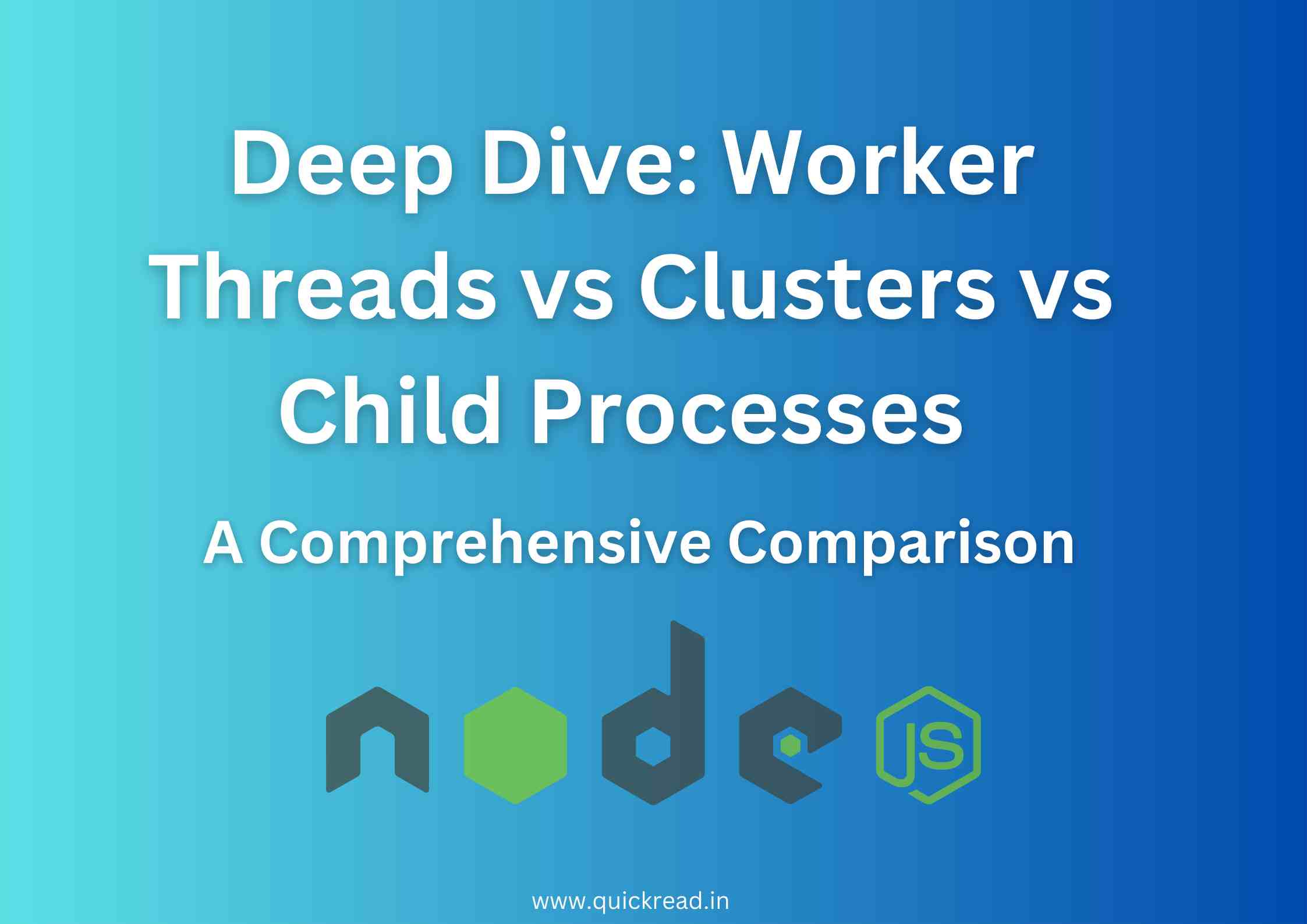Introduction
In the dynamic landscape of Node.js, the quest for enhanced performance and optimal use of resources has led developers to delve into the art of multithreading. The contenders vying for the spotlight – Worker Threads vs Clusters vs Child Processes – promise to unlock the latent power of parallel execution, each with its unique approach.
Grasping the Essence of Multithreading
Multithreading, in essence, is the ability of a program to execute multiple threads concurrently. In Node.js, this translates to the simultaneous execution of JavaScript operations, harnessing the full might of modern CPUs to accomplish tasks more efficiently.
Deep Dive: Worker Threads vs Clusters vs Child Processes
Worker Threads: Unleashing Parallelism
Introduced in Node.js v10, Worker provide a dedicated means of creating and managing separate threads, each executing JavaScript independently. This capability is ideal for CPU-intensive tasks, where parallelism shines. Let’s illustrate with an example:
const { Worker, isMainThread, parentPort } = require('worker_threads');
if (isMainThread) {
const worker = new Worker(__filename);
worker.on('message', message => {
console.log(`Received message from worker: ${message}`);
});
} else {
parentPort.postMessage('Hello from Worker Thread!');
}
Here, a Worker Thread is used to offload work to a separate thread, exemplifying parallel execution.
Clusters: Scaling Horizontally with Ease
Clusters take a different route, allowing you to create multiple processes (instances of your app) that share the same server port. This clever strategy spreads incoming connections across instances, harnessing the power of multiple cores. Consider the following scenario:
const cluster = require('cluster');
const http = require('http');
const numCPUs = require('os').cpus().length;
if (cluster.isMaster) {
for (let i = 0; i < numCPUs; i++) {
cluster.fork();
}
} else {
http.createServer((req, res) => {
res.writeHead(200);
res.end('Hello, Node.js Clusters!');
}).listen(8000);
}
Here, a cluster of processes is created, effectively utilizing each CPU core to handle incoming HTTP requests.
Child Processes: Isolation for Robustness
Child Processes offer a distinct approach by spawning separate instances of the Node.js runtime. This isolation prevents a misbehaving process from affecting others. Consider a scenario involving heavy computation:
const { spawn } = require('child_process');
const computePi = spawn('node', ['pi-computation.js']);
computePi.stdout.on('data', data => {
console.log(`Pi value: ${data}`);
});
computePi.on('close', code => {
console.log(`Child process exited with code ${code}`);
});
Here, a Child Process computes Pi asynchronously, safeguarding the main application from potential performance bottlenecks.
Side-by-Side Comparison
| Approach | Use Case | Isolation | Resource Sharing |
|---|---|---|---|
| Worker Threads | CPU-bound tasks, parallel processing | Isolated | Shared memory |
| Clusters | Scalability, load distribution | Shared | Shared port |
| Child Processes | Stability, isolated execution | Isolated | Separate runtime |
Scenarios and Use Cases
- Worker Threads: Ideal for image processing or complex data manipulations.
- Clusters: Suited for scaling out applications, especially with numerous incoming requests.
- Child Processes: Ensures robustness and stability by isolating tasks prone to errors.
Pros and Cons: Striking a Balance
Advantages:
- Improved performance achieved through parallel execution.
- Effective utilization of multi-core CPUs.
- Enhanced responsiveness and decreased latency.
Disadvantages:
- Heightened code complexity arising from synchronization needs.
- Possibility of resource contention and added memory overhead.
Guiding the Decision-Making Process
- Determine the nature of the task: Is it CPU-bound, I/O-bound, or a mix of both?
- Assess the need for isolation to avoid interference.
- Take into account the intricacies of resource management and inter-process communication complexity.
Frequently Asked Questions
Q1: Can Worker Threads handle I/O-bound tasks?
A1: While designed for CPU-bound tasks, Worker can be adapted for I/O-bound operations with careful consideration.
Q2: How do Clusters manage incoming connections?
A2: Clusters distribute incoming connections across instances, preventing a single instance from becoming a bottleneck.
Q3: Can Child Processes utilize multiple CPU cores?
A3: Yes, Child Processes can take advantage of multiple CPU cores, ensuring better resource utilization.
Q4: How can I decide between Clusters and Child Processes for scaling?
A4: This excel at load distribution, while Child Processes focus on stability and task isolation.
Q5: What’s the recommended approach for shared data handling?
A5: Worker offer shared memory, while Clusters and Child Processes require inter-process communication mechanisms.
Conclusion
The triumvirate of Worker Threads, Clusters, and Child Processes in Node.js unlocks the potential of multithreading, enabling developers to optimize performance and resource usage. Armed with real-world examples and a clear understanding of their strengths and trade-offs, you can confidently choose the right multithreading strategy for your specific needs.


